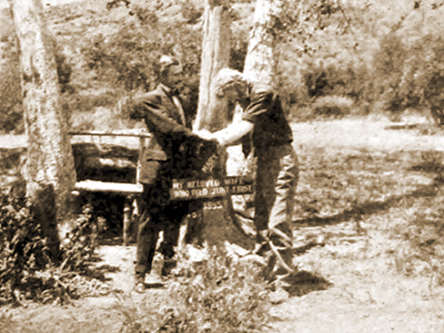| |
 |
| |
Photograph: Silent Era image collection.
|
In the Right of Way
Also known as {In the Right Way}
(1911) United States of America
B&W : One reel
Directed by [?] William F. Haddock?
Cast: Francis Ford [John Walsh], [?] William Clifford? [John Burton], [?] Eleanor Blanchard? [John Walsh’s wife]
G. Méliès production, distributed by The General Film Company, Incorporated. / Produced by Gaston Méliès. Cinematography by [?] William Paley? / Released 13 July 1911. / Standard 35mm spherical 1.33:1 format.
Drama: Western.
Synopsis: [?] [From The Moving Picture World]? John Burton, a railroad clerk from the east, was spending his vacation hunting in the wild lands about John Walsh’s shack. One morning, as he was eagerly following a large hawk, which he had already wounded, he lost his balance on the edge of a cliff and plunged down to the stony ground below. His cries for help attracted Walsh’s attention and he was taken to the latter’s cabin, where he was tenderly cared for by Walsh and his wife, until he was able to return to his duties in the east. Walsh’s wife was the apple of his eye, but, like most things that we love, she did not last, and twenty years later we find him a broken old man, living in the days that are gone. Walsh had heard about the new railroad which was to run in his neighborhood, and one day was surprised to find the construction gang on his property, trampling around in the vicinity of his wife’s grave. He threatened them with his shotgun and angrily ordered them off, and when the sheriff later appeared, with a writ of eviction, he ordered him away. The chief engineer received a letter about this time, saying that the president of the road was not satisfied with the progress made and was personally coming to superintend the work. Walsh was the stumbling block in the engineer’s path, and so he armed his men and ordered them to eject Walsh by force. A spirited exchange of shots was in evidence when the president arrived and he was just in time to see his men bring the wounded Walsh from his cabin, while they set about destroying it. The recognition between the two old friends was mutual, for the president was Burton, the former railroad clerk, whose life Walsh had saved. Walsh led the way to the grave of his wife, and explained his reasons for not wanting to vacate the land where all that he held sacred rested in peace. Burton sympathized deeply with his old friend, and arranged with his engineer to make a wide detour about the property, so that the memory of the dead might be respected.
Reviews: [The Moving Picture World, 29 July 1911, page ?] This picture, though interesting, is not so convincing as some of the recent Melies pictures. One of its faults is that its first scenes suggest another kind of ending. We’ve often seen the husband of a happy family bring home a wounded stranger and expected to see this one grow jealous like the others. Because of these other trite plays it was natural for us to expect it, and the expectation kept us from understanding the situation. One of the worst banes of art is the labor necessary to keep any work clean of suggestions that lead the mind away from the right path. These suggestions are hidden everywhere, and they’ve made many a lesser poet ridiculous. The sharp gun-fight between the man, grown old, and the engineers of the railroad, while possible, is hardly convincing. A man would have needed to sleep and the engineers should have tried other means than a daylight, direct attack. The fact that he was protecting his wife’s grave from being desecrated by the new railroad is the play’s strong point; it saves the picture.
Survival status: (unknown)
Current rights holder: Public domain [USA].
Keywords: USA: Texas
Listing updated: 26 May 2024.
References: Thompson-Star pp. 75, 207-209, 230 : ClasIm-226 p. 55 : Website-IMDb.
|




































